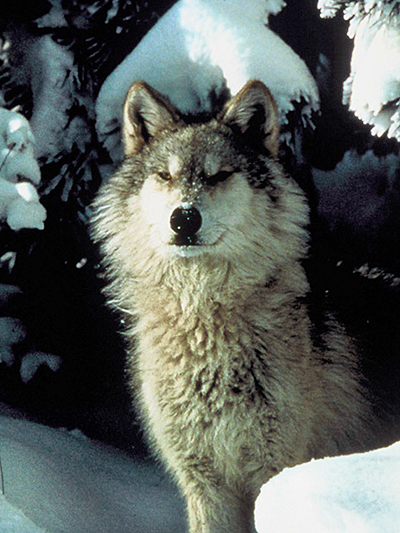Life After Life
Hidden within our soils are a host of organisms engaged in decomposition, that deconstruction project without which life on Earth would long since have disappeared. As with other ecological systems, this one is an iceberg: The part we can’t see is far bigger and more complex than the small fragments that intrude into our everyday lives. Most of the time, then, we are able to remain blissfully unaware of where everyone’s next meal is coming from. We may be able to talk comfortably about the water cycle, despite the probability of eventually drinking “Cleopatra’s bathwater,” but most of us would rather not examine the nutrient cycle too closely. Perhaps the Halloween season is a good time to talk a bit about the fate that awaits us all, humans, mice, and pine trees alike. Though some may say “we’re a long time dead,” the truth is that, sooner or later, reincarnation is a virtual certainty. We’re not immortal, but the chemicals within us are.
Most of the critters that carry out the phases of decomposition spend much of their lives in soil or in the litter layer that often covers it. The first steps, of course, are occasionally carried out by larger organisms, like mice and squirrels and cows, who eat plant materials and then deposit the indigestible portions on the ground. In the global cycle, that’s only an optional side trip for carbon and nitrogen—most of the organic material tied up in plants, even in the hugest redwoods, will be released by much smaller organisms, those we tend to dismiss as insignificant.
Only in size can we easily dismiss them, for soil life is diverse and abundant. In a good season, one prairie acre might harbor two billion microarthropods (such as mites and springtails), as many as five million earthworms, and 200,000 millipedes. A host of insects and macroarthropods, such as fly larvae, termites, pillbugs, and crickets, also participate in decomposition. Outnumbering them all would be the nematodes, or roundworms: At 22 billion per acre, they are among the most abundant organisms on the planet, and are found in pretty much everything and everybody. In the prairie environment, almost half of the nematodes feed on fungi, which are also abundant soil inhabitants, along with the couple of tons of bacteria also present.
A forest ecosystem, of course, is equally dependent on those tiny soil inhabitants, and some forests produce enough organic matter to support even larger populations of such critters. In our dry forests, decomposition is far less obvious than in the moister forests across the great divide. It may go on more slowly, but still it must go on. It may have to hide, literally, from the light of day, but this is one process that works just fine in the dark. Unless we go looking for evidence of decomposition, sifting through leaves and litter or kicking open rotting logs, we will rarely see this process in action.
When conditions are just right, with cool weather and a little moisture, the last participants in the decomposition process begin to “flower,” reminding us of this unsuspected underground world. Suddenly, often overnight, mushrooms appear in our meadows and forests. Their forms are as varied as their cryptic lifestyles, and we often name them for their underworld associations: Destroying Angel, Jack-o’-lantern, Devil’s Snuffbox, Witches’ Butter, Dead Men’s Fingers are all names that remind us Halloween is approaching. And all are the tips of their own respective icebergs, appearing above ground to spread their spores, ensuring that nowhere on Earth will dead things go undecomposed. If one Giant Puffball (Calvatia gigantea) can produce seven trillion spores, few acres will miss receiving their fair complement.
The real decomposition work, however, is being done by the mycelium, a webby mass of underground strands, called hyphae, that makes up the body of the fungus and occasionally produces the “fruit” we see. Some mycelia are annuals that grow from a single spore each year and die after one season. In contrast, other fungi form “fairy rings,” whose fantasy name reflects our attempt to explain their mysterious origin. Whether produced by deadly Amanita or delicate Marasmius, the rings are formed by the outward growth of mycelia that live year after year and form mushrooms only where they are actively growing. Fairy rings have been found in Colorado that may have taken more than 500 years to develop.
Puffballs spread their spores on the wind, as our child-selves know, but some mushrooms depend on animals to consume the tempting fruits and spread the spores; the stinkhorns even attract flies for that purpose. Slugs, mice, turtles, and squirrels, as well as deer and cattle, will eat these seasonal temptations when they can. We humans are also attracted by the culinary qualities of many species of mushrooms, and by the exotic substances (hallucinogenic or merely deadly) produced by others. The economic importance of edible mushrooms and the yeasts who bring us beer and bread is offset a bit by the financial havoc wrought by the many fungi that cause tree and crop diseases. In the end, however, both of these aspects pale in comparison to the service soil fungi provide us by assuring the final chemical breakdown of organic matter into its constituent minerals. Without the help of these fungi and other decomposers, the continual recycling of life from one form to another would end, and the wheels of chemical reincarnation would stop turning forever.
Copyright © 2013 Sally L. White



